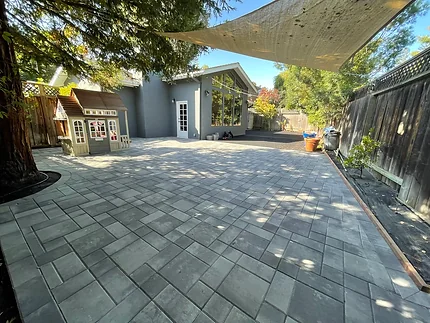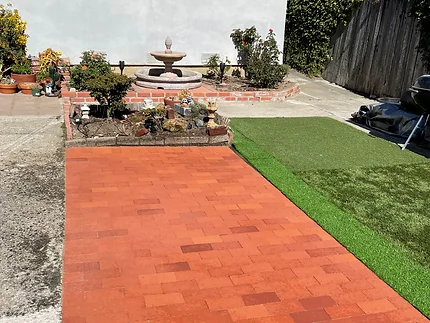What Is the Best Paver for a Pool Deck?
Travertine Pavers (Best for Heat + Slip Resistance)
Travertine is the gold standard for residential pool decks. The reason is that it stays naturally cool, even under intense summer sun. Its porous surface provides excellent slip resistance, making it ideal for safety-conscious families.
Concrete Pavers (Most Affordable + Versatile)
Concrete pavers offer unbeatable durability at a lower price point compared to natural stone. You’ll find countless shapes, textures, and colors perfect for matching modern San Jose homes or Mediterranean-style properties in Walnut Creek and Pleasanton.
Porcelain Pavers (Modern, Minimal-Maintenance Choice)
Porcelain doesn’t fade, crack, or absorb water. It’s one of the best options for luxury modern poolscapes, especially in properties that lean toward a clean, architectural aesthetic.
Limestone or Sandstone (For a Warm, Natural Aesthetic)
These stones are beautifully understated and blend well with drought-friendly landscapes, though they typically require more maintenance and sealing.

Pros and Cons of Pool Deck Pavers
Pros
1. Superior Slip Resistance
Textured pavers grip better when wet. This makes them safer than smooth-stamped concrete, especially in foggy coastal zones like Pacifica or Daly City, where moisture lingers. So, pavers offer better safety for the pool deck.
2. Cooler Surface Options
Travertine and lighter-toned natural stone stay as much as 15–20°F cooler underfoot, making them ideal for East Bay hot spots like Brentwood or Livermore.
3. Better Drainage
Paver joints allow water to escape rather than pooling on the surface. This reduces algae growth and slippery conditions.
4. Easy Repairs
If a paver cracks, shifts, or stains, you can replace a single unit instead of an entire slab.
5. Customizable Designs
Whether you want a clean, modern deck or a Mediterranean resort look, pavers offer endless layouts, borders, and color combinations.
Cons
1. Higher Upfront Installation Costs
Quality-based prep and professional installation of pavers cost more than simple poured concrete.
2. Weed Growth (If Installed Poorly)
Cheap sand or improper edging can lead to weeds pushing through the joints. This can be avoided by hiring experienced installers.
3. Potential for Settling
Older Bay Area soils, especially hillside properties, may shift over time without proper compaction.
4. Some Pavers Get Hot
Dark concrete pavers absorb more heat and may be uncomfortable in heavily sun-exposed areas.
5. Sealing Needed for Natural Stone
Materials like travertine and sandstone generally require sealing every 2–3 years for optimal performance.
What Pavers Stay Coolest Around Pools?
If your priority is comfort in bare feet, choose materials that naturally reflect heat:
- Travertine (Top Choice)
Stays cool even in direct sunlight. - Sandstone (Light Colors)
Low thermal absorption makes it great for sunny yards. - Porcelain Pavers (Specialized Cool Collections)
Manufacturers now make “cool surface” porcelain lines specifically for pool decks. - Light-Colored Concrete Pavers
The lighter the surface, the cooler the feel.
Avoid dark gray, charcoal, or black tones unless your pool deck is heavily shaded.
How Long Do Pool Pavers Last?
Paver Material | Typical Lifespan | Maintenance Level | Pros | Cons |
Concrete Pavers | 25–50 years | Low | Very durable, fade-resistant, and easy to replace individual units | Dark colors can get hot, can shift if base prep is poor |
Travertine | 20–30+ years | Medium | Naturally cool surface, slip-resistant, luxury look | Requires sealing, sensitive to harsh chemicals if unsealed |
Limestone / Sandstone | 20–30+ years | Medium–High | Natural aesthetic, stays relatively cool | Requires sealing, more porous, can weather faster in saltwater |
Porcelain Pavers | 50+ years | Very Low | Extremely durable, UV-resistant, doesn’t absorb water, modern look | Higher upfront cost, heavier to install |
Factors That Affect Lifespan:
- UV and constant sun exposure
- Saltwater vs. chlorine pool chemistry
- Soil conditions (Bay Area clay expands/contracts)
- Base preparation quality
- Sealing and care routines
What to Consider Before Installing Pool Deck Pavers?
1. Slip Resistance
Safety should be the priority. Look for textured or non-slip rated pavers.
2. Heat Reflection
Choose light tones if your backyard gets intense sun or lacks shade.
3. Pool Type
Saltwater pools are easier on porcelain and travertine than on some concrete blends.
4. Drainage Planning
Pavers need a properly engineered base and slopes to prevent puddling.
5. Maintenance Commitment
Natural stone = more sealing.
Concrete pavers = easy upkeep.
Porcelain = almost none.
6. Compatibility With Landscaping
Consider how your paver color, texture, and size pair with retaining walls, coping, steps, and planter borders.

How to Style Pool Deck Pavers
Modern Pool Deck Look
- Large-format porcelain or 24×24 concrete pavers
- Clean, geometric patterns
- Gray or cream tones
- Minimalist borders
Mediterranean Resort Look
- Ivory or walnut travertine
- Random ashlar patterns
- Curved coping and warm tones
Coastal Bay Area Look
- Light limestone or sandstone
- Driftwood-style furniture
- Soft, natural transitions into the landscape
Budget-Friendly Styling
- Simple concrete pavers with decorative gravel borders
- Large pavers spaced with turf strips for a resort grid
- Mixing pavers with gravel lounge zones
Small Pool Decks
- Use larger pavers to visually expand the area
- Keep patterns simple
- Avoid heavy contrast borders that interrupt the eye
Conclusion: Choosing the Right Pool Deck Pavers for Your Bay Area Home
Pool deck pavers offer high durability, safety, and beauty when smartly designed and installed correctly. Whether you’re drawn to cool natural travertine, modern porcelain, or versatile concrete pavers, the right material can completely transform your outdoor living space and boost your home’s long-term value.
If you’re planning a new pool deck or upgrading an existing one, GLscape Inc. is here to help. Our team has installed hundreds of custom paver systems throughout the San Francisco Bay Area, and we can guide you toward materials that look stunning, stay cool, and last for decades. Contact us today for a free on-site consultation.
